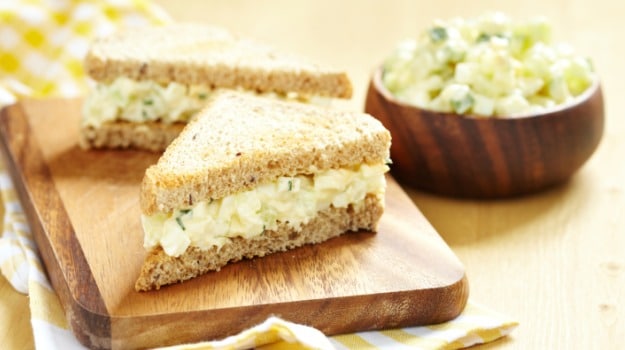'To snack or not to snack?' This has been the one question which has always bothered us, not anymore.
To begin with, know that healthy eating requires planning while snacking arises out of spontaneity. It strikes you in your weakest moments that are often followed by regret. So, how can you help yourself out of the cookie jar? You don't need to. The only thing you need to do is to learn the rules of the game - when, what and how to sneak mini-meals into your day.
But first, why does it make sense to snack? "Snacking in between the meals is an effective way to add those extra nutrients in the diet which are usually missing in our daily food intake. Eating snacks prevents you from overeating later in the day and boosts your metabolism which triggers weight loss," says Nutritionist and Weight Management Expert, Gargi Sharma.
If you've been shying away from snacking, you're mistaken. Or probably you never bumped into the idea of healthy snacking. For starters, it has five characteristics and to reiterate yes, it exits. These characteristics are - adequacy, balance, calorie control, moderation, and variety. Adequacy will have you consume the correct amount of nutrients and energy that your body needs in a day while creating a balance between all essential food groups. Moderation forms the foundation of a sound diet. Controlling the calories directly affects your weight and so does limiting the amount of sugar, salt and fat. But, you don't need to limit your choices. Variety keeps you motivated, breaks the monotony and fights sudden snack attacks.
"The frequency of meals is also important as it maintains your metabolism and helps in smooth digestion of our meals. Mini-meals should be taken in intervals of 2-3 hours so as to keep your metabolic rate stable," adds Nutritionist, Niharika Rana.
Your focus should be to change the way you eat. Here's your cheat sheet to conquer your cravings and win at life.
When to snack
The first rule is to never starve a rumbling belly. When your body is deprived of food for a period longer than three to six hours, it enters into starvation mode. That's also when your blood sugar starts to dip. During this phase your metabolism decreases, cravings increase and chemical called Neuropeptide Y (NPY) is produced that triggers the need for carbohydrates.
"One should have three nutritionally balanced meals with two small snacks in between. One snack should be eaten in the afternoon and one in the evening. This will help you control your calories intake as it prevents those untimely cravings," recommends Gargi.
We often hear that late-night snacking is a bad idea and studies have shown that it is true. Your internal body clock regulates calorie expenditure differently during different times. Therefore, when you eat is as important as what you eat. Sometimes, lack of sleep may trigger unnecessary cravings. Insufficient sleep may affect the levels of hormones ghrelin and leptin, which regulate feelings of hunger and fullness.
(Worst Foods That Ruin Your Sleep)
According to Nutritionist Niharika Ahluwalia,"Late night snacking should be avoided because it decreases the metabolic rate. Also, if we eat a high carbohydrate snack like a sandwich or a biscuit at night then our sugar levels tend to increase. If at all you are hungry go for high fibre snacks like fruits and salads."
What to snack on
A healthy snack is one that leaves you satisfied. After we eat, nerve receptors in our stomach send signals to the brain to regulate whether the body desires more food. Pick a snack that has a high satiety value or one that keeps you full for longer. Snacks that have high water content or are loaded with fiber and protein send strong satiety signals to the brain and curb cravings.
"Snacks with a combination of carbohydrates and proteins are the perfect snacks for midnight munching. One can opt foods like low fat yogurt, small bowl of oatmeal, fresh fruits or roasted channa," suggests Gargi
Nutritionist Niharika Ahluwalia recommends the following -
1. Fresh fruits such as apples, bananas, grapes, oranges, strawberries and watermelon
2. Raw vegetables including carrots, celery, or broccoli, that can be served with a low-fat dip or dressing
3. Dairy products such as low-fat cheese, yogurt or homemade fruit smoothies.
4. Energy bars
5. Oat or ragi biscuits
6. Butter milk
7. Coconut water
8. Dried figs
9. Roasted dry fruits
10. Murmure (puffed rice)
11. Sprouts
How to snack
Mindful eating seems to be the buzzword for 2015. It is a concept that stems from Buddhist teachings and aims at making the experience of eating more enjoyable. You focus on the food - flavours, textures, taste and aroma. Your senses are not only more aware but deeply satisfied. It's as easy as chewing your food slowly and eating in silence. Some studies indicate that the longer you chew, the more full you feel.
(10 Foods that Suppress Your Appetite and Leave You Feeling Full)
A study conducted at the University of Birmingham in 2009 showed that if you are distracted during meals or are multi-tasking, you'd be less satisfied and are likely to binge later. Being less satisfied can trick your brain into overeating, even though your body may not be hungry.









